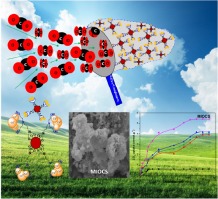Journal of the Taiwan Institute of Chemical Engineers ( IF 5.5 ) Pub Date : 2018-09-14 , DOI: 10.1016/j.jtice.2018.08.020 J. Vieillard , N. Bouazizi , R. Bargougui , P. Nkuigue Fotsing , O. Thoumire , G. Ladam , N. Brun , J.-F. Hochepied , E. Djoufac Woumfo , N. Mofaddel , F. Le Derf , A. Azzouz

|
A novel hydrochar-based core–shell material with improved affinity towards CO2 was synthesized through encapsulation within ZnO shell, followed by chemical grafting to an organic moiety bearing terminal diethanolamino groups and further dispersion of Cu0 nanoparticles. Characterization through nitrogen adsorption–desorption isotherms with BET and BJH models, SEM, TEM, zeta potential measurements, FTIR spectroscopy, DSC and XPS analyses revealed a strong influence of the modification procedure on the performance of each material in CO2 adsorption. The resulting metal-inorganic-organic-core–shell (MIOCS) displayed compacted structure with a wide pore size distribution that imposes intraparticle diffusion as a kinetic-controlling step. Cu-MIOCS showed an appreciable CO2 retention capacity of 5.42 mmol/g compared to many adsorbents reported so far. This affinity towards CO2 was explained in terms of physical and non-stoichiometric CO2 condensation. This finding is of great importance, because it demonstrates that judicious modifications of vegetal-deriving wastes such as woods and other biomasses give rise to added-value materials as low cost and efficient gas adsorbents with high affinity towards CO2.
中文翻译:

金属-无机-有机核-壳材料作为CO 2吸附的有效基质:合成,性质和动力学研究
通过封装在ZnO壳中,然后化学接枝到带有末端二乙醇氨基的有机部分上,并进一步分散Cu 0纳米颗粒,合成了一种新型的基于水碳的核壳材料,具有对CO 2的亲和力。通过使用BET和BJH模型进行的氮吸附-解吸等温线表征,SEM,TEM,ζ电位测量,FTIR光谱,DSC和XPS分析,揭示了改性程序对每种材料在CO 2中的性能产生了强烈影响。吸附。由此产生的金属-无机-有机-核-壳(MIOCS)表现出致密的结构,具有宽的孔径分布,这迫使颗粒内扩散成为动力学控制步骤。与迄今为止报道的许多吸附剂相比,Cu-MIOCS表现出明显的CO 2保留容量为5.42 mmol / g。通过物理和非化学计量的CO 2缩合解释了对CO 2的这种亲和力。该发现非常重要,因为它表明,对诸如木材和其他生物质之类的植物性废物进行明智的改造,可以形成具有高附加值的材料,成为低成本,高效的对CO 2具有高亲和力的气体吸附剂。











































 京公网安备 11010802027423号
京公网安备 11010802027423号